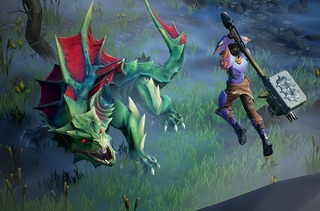Créé en 2014 par des vétérans de l'industrie du jeu en ligne, le studio Phoenix Labs dévoile finalement son premier projet : Dauntless, un jeu en ligne coopératif reposant sur du jeu de groupe face à des bosses d'envergure.
On se souvient qu'en 2014, une équipes de vétérans de l'industrie du jeu en ligne (ayant fait ses armes chez Riot Games, Blizzard, Bioware ou Capcom) menée par Jesse Houston annonçait la création du studio Phoenix Labs au Canada, pour concevoir des jeux en ligne multijoueur « AAA ».
Hier soir, le studio profitait de la cérémonie des Game Awards 2016 pour dévoiler officiellement le projet en développement depuis deux ans, Dauntless, un titre qui revendique une inspiration trouvée à la fois dans League of Legends, les Monsters Hunter ou encore World of Warcraft.
Dauntless est ainsi présenté comme un RPG d'action coopératif, jouable en ligne et distribué en free-to-play. Le joueur est plongé au coeur des Mondes Brisés, un univers ravagé par un cataclysme et envahi de béhémoths, des créatures colossales et hostiles, ayant obligé l'humanité à se réfugier sur des îlots volants. Alors que l'humanité est menacée d'extinction, les slayers (les joueurs) lancent ponctuellement des raids au sol pour traquer et éliminer les béhémoths...
Dans ce contexte narratif, Dauntless se veut donc un jeu résolument coopératif, dans lequel des équipes de joueurs devront développer des synergies et du jeu de groupe pour affronter des bosses qu'on nous promet redoutables. Il faudra donc faire progresser son personnage, mais aussi l'équiper en forgeant ses armes.
Attendu sur PC l'année prochaine, Dauntless doit être distribué en free-to-play et faire l'objet de mises à jour régulières (de nouveaux scénarios ou de nouveaux béhémoths, par exemple, devraient apparaitre ponctuellement dans l'univers de jeu). D'ici là, le jeu se dévoile (un peu) sur un site officiel où l'on peut d'ores et déjà s'inscrire afin de « réserver son nom » et suivre les évolutions du projet.

Réactions (24)
Afficher sur le forumPas de compte JeuxOnLine ?
Créer un compte